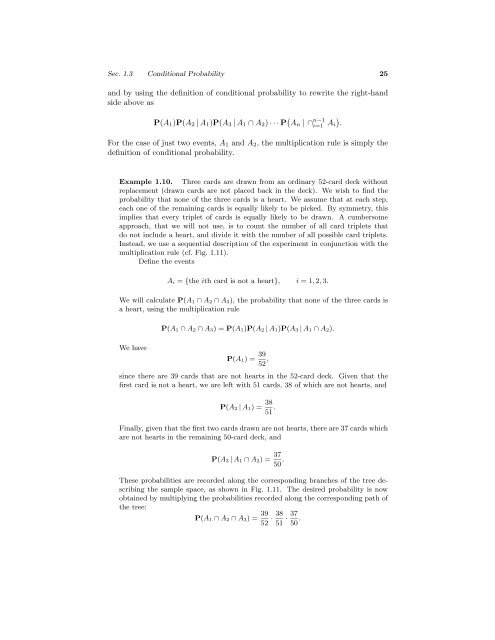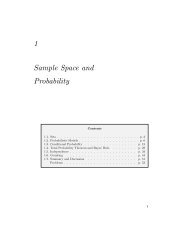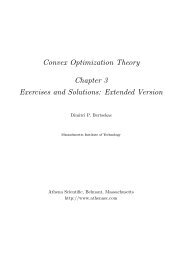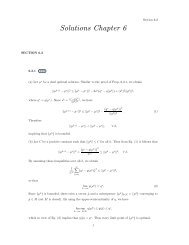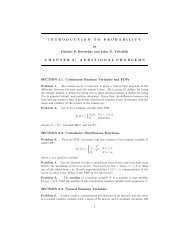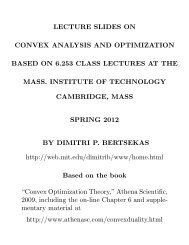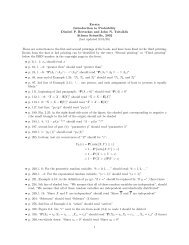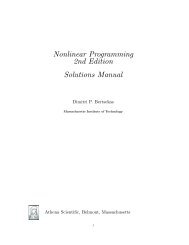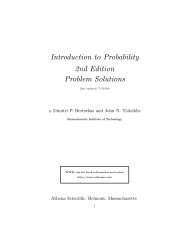Introduction to Probability, by Dimitri P ... - satrajit mukherjee
Introduction to Probability, by Dimitri P ... - satrajit mukherjee
Introduction to Probability, by Dimitri P ... - satrajit mukherjee
Create successful ePaper yourself
Turn your PDF publications into a flip-book with our unique Google optimized e-Paper software.
Sec. 1.3 Conditional <strong>Probability</strong> 25<br />
and <strong>by</strong> using the definition of conditional probability <strong>to</strong> rewrite the right-hand<br />
side above as<br />
P(A 1 )P(A 2 | A 1 )P(A 3 | A 1 ∩ A 2 ) ···P ( A n |∩ n−1<br />
i=1 A i)<br />
.<br />
For the case of just two events, A 1 and A 2 , the multiplication rule is simply the<br />
definition of conditional probability.<br />
Example 1.10. Three cards are drawn from an ordinary 52-card deck without<br />
replacement (drawn cards are not placed back in the deck). We wish <strong>to</strong> find the<br />
probability that none of the three cards is a heart. We assume that at each step,<br />
each one of the remaining cards is equally likely <strong>to</strong> be picked. By symmetry, this<br />
implies that every triplet of cards is equally likely <strong>to</strong> be drawn. A cumbersome<br />
approach, that we will not use, is <strong>to</strong> count the number of all card triplets that<br />
do not include a heart, and divide it with the number of all possible card triplets.<br />
Instead, we use a sequential description of the experiment in conjunction with the<br />
multiplication rule (cf. Fig. 1.11).<br />
Define the events<br />
A i = {the ith card is not a heart}, i =1, 2, 3.<br />
We will calculate P(A 1 ∩ A 2 ∩ A 3), the probability that none of the three cards is<br />
a heart, using the multiplication rule<br />
P(A 1 ∩ A 2 ∩ A 3)=P(A 1)P(A 2 | A 1)P(A 3 | A 1 ∩ A 2).<br />
We have<br />
P(A 39<br />
1)=<br />
52 ,<br />
since there are 39 cards that are not hearts in the 52-card deck. Given that the<br />
first card is not a heart, we are left with 51 cards, 38 of which are not hearts, and<br />
P(A 2 | A 1)= 38<br />
51 .<br />
Finally, given that the first two cards drawn are not hearts, there are 37 cards which<br />
are not hearts in the remaining 50-card deck, and<br />
P(A 3 | A 1 ∩ A 2)= 37<br />
50 .<br />
These probabilities are recorded along the corresponding branches of the tree describing<br />
the sample space, as shown in Fig. 1.11. The desired probability is now<br />
obtained <strong>by</strong> multiplying the probabilities recorded along the corresponding path of<br />
the tree:<br />
P(A 1 ∩ A 2 ∩ A 39<br />
3)=<br />
52 · 38<br />
51 · 37<br />
50 .


